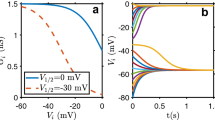Abstract
A perturbed microenvironment is at the core of carcinogenesis. Here, we used a 2D cellular automata model to simulate how cancers are generated in epithelial tissue. We applied several mathematical rules to simulate tissue renewal and surrounding cell control. Under the simulation, we showed that the average value of surrounding normal cells could be an indicator for the tissue normalizing capacity (TNC). Further, we found the incidence of carcinogenesis correlated inversely with the TNC. Interestingly, we also found that multi-round mutagenesis could gradually disturb the TNC when compared to one-round mutagenesis: cancer incidence increased significantly compared to one-round mutagenesis. Our model suggests that the genetic alterations (mutations) by themselves were not sufficient to initiate cancer. The perturbation of TNC could be a key process leading to carcinogenesis.



Similar content being viewed by others
References
Alarcon T, Byrne HM et al (2003) A cellular automaton model for tumour growth in inhomogeneous environment. J Theor Biol 225:257–274
Alexander DB, Ichikawa H et al (2004) Normal cells control the growth of neighboring transformed cells independent of gap junctional communication and Src activity. Cancer Res 64:1347–1358
Anderson ARA, Chaplain MAJ (1998) Continuous and discrete mathematical models of tumor-induced angiogenesis. Bull Math Biol 60:857–899
Baker SG, Soto AM et al (2009) Plausibility of stromal initiation of epithelial cancers without a mutation in the epithelium: a computer simulation of morphostats. BMC Cancer 9:89–99
Booth BW, Boulanger CA et al (2011) The normal mammary microenvironment suppresses the tumorigenic phenotype of mouse mammary tumor virus-neutransformed mammary tumor cells. Oncogene 30:679–689
Boveri T (1929) The origin of malignant tumors. Williams & Wilkins, Baltimore, MD, pp 62–63
Braakhuis BJ, Tabor MP et al (2003) A genetic explanation of Slaughter’s concept of field cancerization: evidence and clinical implications. Cancer Res 63:1727–1730
Brash D, Cairns J (2009) The mysterious steps in carcinogenesis. Br J Cancer 101:379–380
Bussard KM, Boulanger CA et al (2010) Reprogramming human cancer cells in the mouse mammary gland. Cancer Res 70:6336–6343
Dalerba P, Cho RW et al (2007) Cancer stem cells: models and concepts. Annu Rev Med 58:267–284
Ermentrout GB, Edelstein-Keshet L (1993) Cellular automata approaches to biological modelling. J Theor Biol 160:97–133
Gerard RW (1957) Units and concepts of biology. Science 125:429–433
Haas D, Ablin A et al (1988) Complete pathologic maturation and regression of stage IVS neuroblastoma without treatment. Cancer 62:818–825
Hogan C, Dupre-Crochet S et al (2009) Characterization of the interface between normal and transformed epithelial cells. Nat Cell Biol 11:460–467
Hogan C, Kajita M et al (2011) Interactions between normal and transformed epithelial cells: their contributions to tumourigenesis. Int J Biochem Cell Biol 43:496–503
Kansal AR, Torquato S et al (2000) Simulated brain tumour growth dynamics using a threedimensional cellular automaton. J Theor Biol 203:367–382
Kasemeier-Kulesa JC, Teddy JM et al (2008) Reprogramming multipotent tumor cells with the embryonic neural crest microenvironment. Dev Dyn 237:2657–2666
Kenny PA, Bissell MJ (2003) Tumor reversion: correction of malignant behavior by microenvironmental cues. Int J Cancer 107:688–695
LeBlond CP (1964) Classification of cell populations on the basis of their proliferative behavior. Natl Cancer Inst Monogr 14:119–150
Maffini MV, Calabro JM et al (2005) Stromal regulation of neoplastic development: age-dependent normalization of neoplastic mammary cells by mammary stroma. Am J Pathol 167:1405–1410
McCullough KD, Coleman WB et al (1998) Plasticity of the neoplastic phenotype in vivo is regulated by epigenetic factors. Proc Natl Acad Sci USA 95:15333–15338
Mintz B, Ilmensee K (1975) Normal genetically mosaic mice produced from malignant teratocarcinoma cells. Proc Natl Acad Sci USA 72:3585–3589
Prehn RT (1994) Cancers beget mutations versus mutations beget cancers. Cancer Res 54:5296–5300
Soto AM, Sonnenschein C (2004) The somatic mutation theory of cancer: growing problems with the paradigm? BioEssays 26:1097–1107
Stoker MG, Shearer M et al (1966) Growth inhibition of polyoma-transformed cells by contact with static normal fibroblasts. J Cell Sci 1:297–310
Vincent JP, Fletcher AG et al (2013) Mechanisms and mechanics of cell competition in epithelia. Nat Rev Mol Cell Biol 14:581–591
Wolfram S (1984) Cellular automata as models of complexity. Nature 311:419–424
Acknowledgments
I thank Prof. Stuart G Baker, from Biometry Research Group, Division of Cancer Prevention, National Cancer Institute, Bethesda, USA, for the critical review of the manuscript. I also thank Prof. Carlos Sonnenschein, from Department of Anatomy and Cell Biology, Tufts University School of Medicine, Boston, USA, for this candid comments and careful revision of the manuscript.
Author information
Authors and Affiliations
Corresponding author
Rights and permissions
About this article
Cite this article
Cao, W. Tissue normalizing capacity as a key determinant of carcinogenesis: an in silico simulation. Biotechnol Lett 37, 551–556 (2015). https://doi.org/10.1007/s10529-014-1725-9
Received:
Accepted:
Published:
Issue Date:
DOI: https://doi.org/10.1007/s10529-014-1725-9




